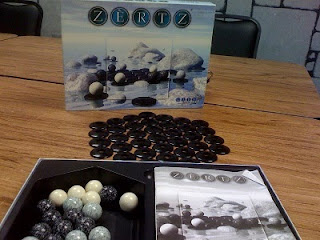I recently received the gift of gaming from my wife (thanks, wife) in the form of Lord Of The Rings: The Confrontation Deluxe Edition
Lord of the Rings: The Confrontation is Stratego on steroids (or, put another way, what Stratego Legends wished it could have been). One of the players selects the role of the free peoples, and the other player takes on the role of Sauron's minions. In order to win, the good guys must get Frodo to Mordor (as in every Lord of the Rings game), and the bad guys must either kill Frodo (again, as in every LotR game) or get 3 of their units in the Shire. To start the game, each player takes their 9 units and places them on their side of the board to where their opponent cannot see them, with 4 of them in their back-most territory (Mordor or the Shire). From there, the players will take turns moving one of the units forward. If their unit enters the same region as an opposing unit, then they will battle. First, the units are revealed and the special text of each of the units will occur (good guys first). Next, each of the players will select one of their fight cards to play, and (if they are text cards), these will resolve (bad guys first). Finally, if nobody has wimped out of the fight and retreated somehow, then the units will compare their strength total, and whoever has the highest total wins (and in a tie, they both die).
The first pro that I like about The Confrontation is that the sides play very differently and are thematically tailored pretty well. If you are playing as the free peoples, then your units are weaker but are more tricky. They have several units that are able to run away, kill certain units instantly, etc. If you are playing as Sauron's minions, then your units are much stronger, but fight primarily with brute strength.With these differences, you will obviously have to have a much different strategy depending on which side you are playing.
The next pro about The Confrontation is that it is ridiculously replayable. This is especially true with the Deluxe Edition. I believe that there are about 5 different variants on the game that can be played. Each unit has two different sides that can be played, and there are also some "special cards" that can be used in a couple of different ways. And then there is even the previously mentioned difference in using the free people versus the minions of Sauron and the replayability involved in switching between sides.
The main con of The Confrontation involved the special movement rules involving the mountains. The middle territories were mountains, and they prevented units from moving sideways in them, unless something specifically stated that they could. This causes you to constantly be referring to the rulebook to see if they really can move through the mountains there or not, and really should have been simplified somehow.
The other thing to note about The Confrontation is that I think it will ultimately live its life as a filler game. Like Stratego, I don't really see a lot of people getting together specifically to play it. I think that some people may do this, as it is a very good game, but it is brief enough that I don't think that people will make a point of meeting up to play it.
Overall, I give Lord of the Rings: The Confrontation (Deluxe Edition) an 8.5/10. As a disclaimer, my wife would horribly disagree with this score, as she hated the game and thought that the sides were unbalanced - you may want to be aware of this if you are considering buying this to play with your spouse. However, as a whole, I would recommend checking this out if you like how Stratego works.
For more reading, you might check out the Board Game Family's Lord of the Rings: Confrontation Review, or my reviews of Mage Wars, King of Tokyo, and Mice and Mystics.







